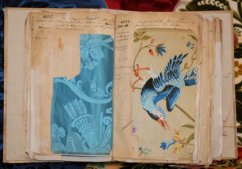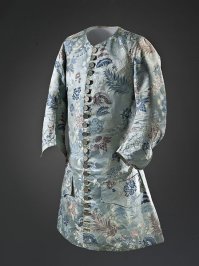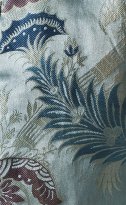- Home
- Resurrection ▾
-
Learn ▾
- Free library
- Glossary
- Documents
- Initiation
-
Shaped fabrics
- Introduction
- Popularization
- Definitions
- Le métier de façonné
- Principes du façonné
- Mécaniques de façonné
- Le jeu des crochets
- Les cartons
- Chaîne des cartons
- Mécanique 104 en détail
- Pour en finir
- Montage façonné
- Empoutage 1/3
- Empoutage 2/3
- Empoutage 3/3
- Punching, hanging and dip
- Autres façonnés
- Façonnés et Islam
-
Cours de tissage 1912
- Bâti d'un métier
- Le rouleau arrière
- Les bascules
- Formation du pas
- Position de organes
- Mécanique 104 Jacquard
- Fonctionnement 104
- Lisage des cartons
- Le battant du métier
- Le régulateur
- Réduction et régulateur
- Mise au métier d'une chaîne
- Mise en route du métier
- Navettes à soie
- Battage
- Ourdissage mécanique
- Préparation chaînes et trames
- Equipment ▾
- Chronicles ▾
- Fabrics ▾
- Techniques ▾
- Culture ▾
- Language ▾
Lampas nué broché, Livre de patrons Maison Prelle, 1831
Men's jacketFrance, 1715


The Lampas
Originally contested, this name could come from laba or labba, a piece of cloth in French. This sumptuous fabric is fashioned on pickpockets. It is probably originated in China or Persia. The lampas is a fabric assembling silk threads, sometimes gold and silver, the motifs of which are in relief, and known in Europe from the tenth century. It is a cousin of Damascus, the peculiarity of which is the use of two chains, one for binding the weft decoration and the other for the satin or twill bottom. Lampas was very common in France under Louis XV.

To give an exact and definitive definition of the lampas seems to be a challenge, as its variants have been numerous according to places and times.
Here is the definition of a reliable instance:
Historical Museum of the tissues of Lyon:A fabric whose decoration is constituted by floats of weft regularly bound in taffeta or in twill by an auxiliary chain called chain of binding. This decoration is detached on a background produced by the main chain frequently satin, but can be any armor.